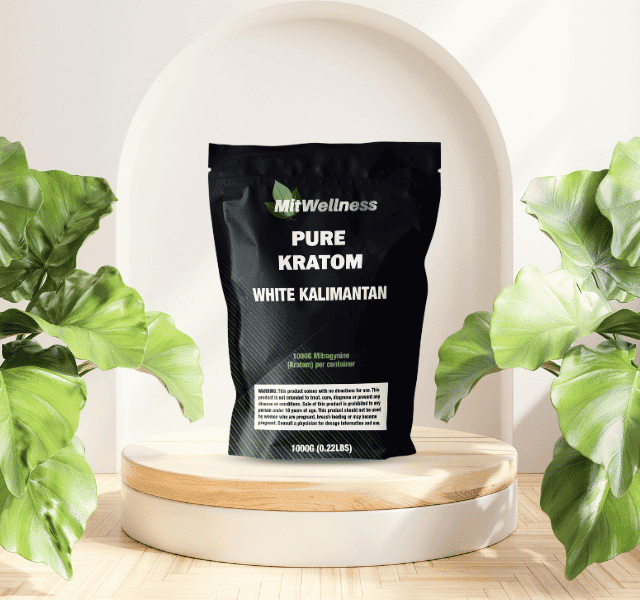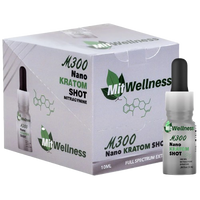 It’s essential to explore the chemistry of kratom within the broader context of its chemical structure. Kratom’s chemical properties need to be understood to comprehend its effects and application.
It’s essential to explore the chemistry of kratom within the broader context of its chemical structure. Kratom’s chemical properties need to be understood to comprehend its effects and application.
Chemical Composition: At the core of kratom’s chemistry are alkaloids, including Mitragynine and 7-Hydroxymitragynine. These compounds interact with receptors in the brain, influencing how you feel and mood regulation. The variation in alkaloid content among different strains contributes to the diverse range of effects kratom can produce.
Chemical Structure: Mitragynine and 7-Hydroxymitragynine possess structural similarities to other drugs, enabling them to bind to the brain’s receptors. This interaction underlies kratom’s potential as an analgesic and as a tool for relief management.
Terpene Profile: Kratom’s chemistry extends beyond alkaloids. Terpenes, aromatic compounds found in kratom, play a role in its aroma and may contribute to its effects. Understanding the terpene profile can provide insights into kratom’s nuanced attributes.
Polyphenol Content: Polyphenols are another group of compounds present in kratom. These molecules possess chemical properties, suggesting potential health benefits beyond its alkaloid content.
Extraction Methods: To harness the beneficial compounds in kratom, various extraction methods are employed, each yielding distinct products with varying potency and effects.
Pharmacological Properties: Kratom’s pharmacology is multifaceted, with effects ranging from relief to sedation, depending on the strain and serving size. These properties make it a subject of scientific interest and potential clinical utility.
Variability in Alkaloid Content: Kratom’s alkaloid composition can fluctuate due to factors like genetics and environmental conditions. This variability underscores the importance of standardized testing and quality control.
Interaction with Other Drugs: Understanding how kratom interacts with other substances, including prescription medications, is crucial for ensuring safety and preventing potential adverse effects.
Analytical Testing: Detecting kratom in biological samples requires advanced analytical techniques, essential for research and compliance with regulations.
Solubility: Kratom compounds exhibit varying solubility in different solvents, a critical consideration in the preparation of kratom products.
Alkaloid Concentration: The concentration of key alkaloids in kratom can influence its potency and effects, making it a pivotal aspect of its chemistry.
What is the chemistry of Kratom?
Kratom’s chemistry is a complex and intriguing subject that revolves around its unique chemical composition. At its core, kratom contains several active alkaloids, with Mitragynine and 7-Hydroxymitragynine being the most prominent. These alkaloids interact with receptors in the brain, influencing physical relief and mood regulation. Beyond alkaloids, kratom also boasts a diverse range of compounds, including terpenes and polyphenols, which contribute to its aroma and potential health benefits. Understanding the intricate chemistry of kratom is essential for comprehending its pharmacological properties and potential effects on the human body.
What is the chemical composition of kratom?
The chemical composition of kratom is a fascinating area of study. Kratom leaves are rich in alkaloids, which are nitrogen-containing organic compounds. The primary alkaloids in kratom are Mitragynine and 7-Hydroxymitragynine, but there are several others present in smaller quantities. These alkaloids are responsible for kratom’s effects on the body, including physical relief and mood enhancement. In addition to alkaloids, kratom contains terpenes, polyphenols, and other compounds that contribute to its overall composition. The chemical composition can vary depending on factors such as the kratom strain and growing conditions, which can result in different alkaloid profiles and effects when consumed. Understanding the chemical composition of kratom is crucial for researchers, as it forms the foundation for studying its potential therapeutic properties and interactions with the human body.
What is the chemical structure of kratom?
The chemical structure of kratom is notable for its resemblance to other drugs taken for relief management, despite being a naturally occurring plant compound. The primary alkaloid, Mitragynine, has a complex structure with a pentane ring and a 2-methoxyethyl group. It interacts with receptors in the brain, influencing well being and mood. 7-Hydroxymitragynine, another key alkaloid, also features a similar structure and plays a crucial role in kratom’s effects. Understanding the chemical structure of kratom is essential as it provides insights into how these compounds interact with the body’s receptors, resulting in potential analgesic and mood-enhancing effects.
What is the terpene profile of kratom?
Kratom’s terpene profile contributes to its unique aroma and potential synergistic effects with alkaloids. Terpenes are aromatic compounds found in kratom, and each strain may have a distinct terpene profile. These terpenes can vary from strain to strain and can include familiar terpenes found in other plants, such as myrcene, limonene, and pinene. While research on kratom’s terpenes is ongoing, they are believed to play a role in the overall experience of consuming kratom. Understanding the terpene profile of kratom is essential for those interested in the nuanced differences between kratom strains and their potential effects.
What is the polyphenol content in kratom?
Polyphenols are another group of compounds found in kratom, contributing to its overall chemical composition. These compounds have chemical properties and are believed to offer potential health benefits. While the specific polyphenols present in kratom can vary, they are an important aspect of its chemistry. Understanding the polyphenol content in kratom is essential for researchers exploring its potential health-related properties beyond its alkaloid content. It highlights the multifaceted nature of kratom’s composition and its potential as a subject of scientific interest for various applications.
How does the body metabolize kratom’s compounds?
Kratom metabolism in the body involves complex processes. After consumption, kratom’s alkaloids, particularly Mitragynine and 7-Hydroxymitragynine, are absorbed in the gastrointestinal tract. The liver plays a crucial role in metabolizing these alkaloids through enzymatic processes. The resulting metabolites can have different effects on the body. Mitragynine, for example, is converted into 7-Hydroxymitragynine, which is believed to be responsible for many of kratom’s effects. The metabolism of kratom can vary among individuals due to factors such as genetics and liver function. Understanding how kratom metabolizes in the body is essential for researchers and healthcare professionals to determine amounts, potential effects, and safety considerations.
Are there interactions between kratom and other drugs?
Yes, there can be interactions between kratom and other drugs, and these interactions can have varying effects. Kratom’s alkaloids interact with receptors, which can lead to additive effects when combined with other substances that affect the central nervous system. These interactions can enhance the risk of respiratory issues and other adverse effects. Additionally, kratom may interact with drugs that are metabolized by the liver’s cytochrome P450 enzymes, potentially altering their effectiveness. It is crucial for individuals using kratom or other medications to be aware of potential interactions and consult with healthcare professionals to ensure their safety.
What methods are used for analytical testing of kratom?
Analytical testing of kratom involves various methods to determine its chemical composition and purity. High-performance liquid chromatography (HPLC) is a commonly used technique for quantifying alkaloid content, including Mitragynine and 7-Hydroxymitragynine. Mass spectrometry (MS) can also be employed for precise identification and quantification of kratom compounds. Thin-layer chromatography (TLC) can provide a quick visual analysis of alkaloids. Additionally, nuclear magnetic resonance (NMR) spectroscopy can be used for structural analysis. Proper analytical testing is essential for quality control, ensuring that kratom products meet safety and regulatory standards.
How soluble are kratom chemical compounds?
The solubility of kratom chemical compounds can vary depending on the specific compound and the solvent used. For example, alkaloids like Mitragynine and 7-Hydroxymitragynine are relatively soluble in polar solvents like water and ethanol. However, their solubility can be limited in non-polar solvents. Terpenes and polyphenols in kratom may also exhibit varying solubility depending on their chemical properties. Understanding the solubility of kratom compounds is essential for processes such as extraction and formulation of kratom products, ensuring effective utilization of its chemical constituents.
What are the active compounds in kratom?
Kratom contains a range of active compounds, with Mitragynine and 7-Hydroxymitragynine being the primary alkaloids responsible for its effects. These alkaloids interact with receptors in the brain, leading to relief, mood enhancement, and potential sedation or stimulation depending on the strain and serving size. Additionally, kratom contains other minor alkaloids like Paynantheine and Speciociliatine, which may contribute to its overall effects. Terpenes found in kratom can also be considered active compounds, as they may enhance the aroma and potentially interact with alkaloids to produce distinct effects. Polyphenols, although not primarily responsible for kratom’s immediate effects, are active in the sense that they possess chemical properties, potentially offering health benefits. Understanding these active compounds is crucial for comprehending the diverse range of effects that kratom can produce.
How is kratom’s chemistry detected in testing?
Kratom’s chemistry can be detected in testing through a combination of analytical methods. High-performance liquid chromatography (HPLC) and mass spectrometry (MS) are commonly used techniques for detecting and quantifying kratom’s alkaloids, such as Mitragynine and 7-Hydroxymitragynine. Thin-layer chromatography (TLC) can provide a quick visual analysis of alkaloids. Nuclear magnetic resonance (NMR) spectroscopy is used for structural analysis, providing insights into the chemical composition of kratom. These methods allow for the precise identification and quantification of kratom compounds, ensuring that products are accurately labeled and meet regulatory standards. Proper testing is essential to ensure the safety and quality of kratom products available in the market.
What are the pharmacological properties of kratom’s chemistry?
The pharmacological properties of kratom’s chemistry are diverse and can include analgesic, mood-enhancing, and potential sedative or stimulating effects. The primary alkaloids, Mitragynine and 7-Hydroxymitragynine, interact with receptors in the brain, resulting in physical relief and mood regulation. The pharmacological properties can vary among different strains and depend on factors such as alkaloid composition and serving size. Kratom’s chemistry has also been of interest due to its potential in managing withdrawal symptoms. However, it’s essential to note that the pharmacological properties of kratom are still a subject of ongoing research, and further studies are needed to fully understand its mechanisms and potential therapeutic applications.
Does the growing environment of kratom affect the alkaloid chemistry?
Yes, the growing environment of kratom, including factors like soil composition, climate, and geographical location, can significantly affect its alkaloid chemistry. Kratom strains from different regions may exhibit variations in alkaloid content and profiles. For example, kratom grown in Southeast Asia, where it is native, may have distinct alkaloid compositions compared to kratom grown in other regions. Additionally, variations in weather conditions and soil nutrients can influence alkaloid production. These environmental factors contribute to the diverse range of effects observed in different kratom strains. Researchers and enthusiasts often refer to “strains” of kratom to differentiate between products with varying alkaloid profiles, highlighting the impact of the growing environment on its chemistry. Understanding these variations is essential for both consumers and researchers seeking specific effects from kratom products.
For more information on the chemistry of kratom contact Mitwellness.





















